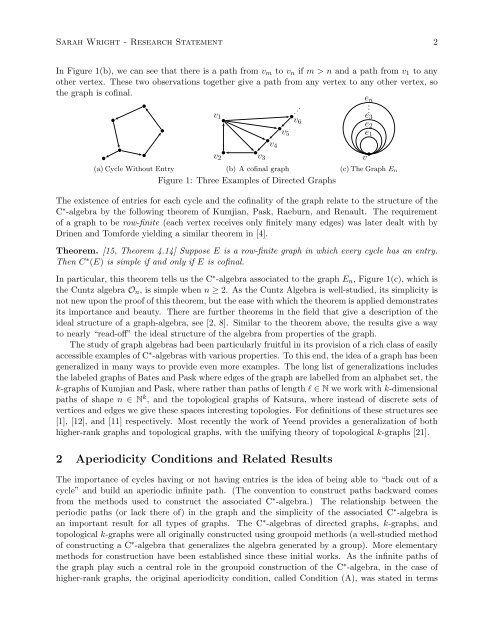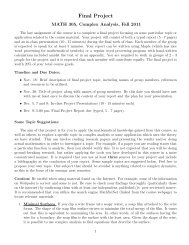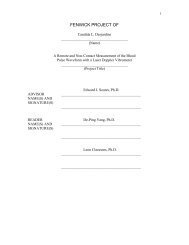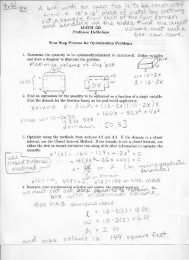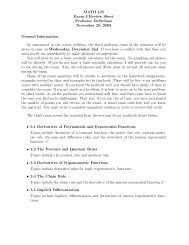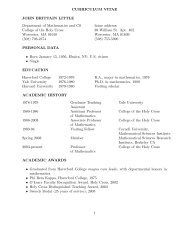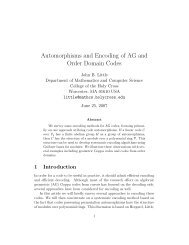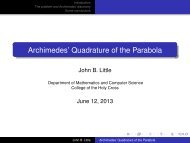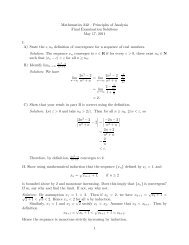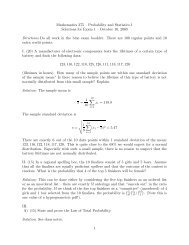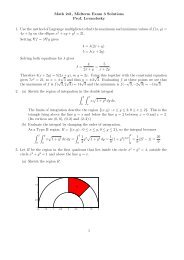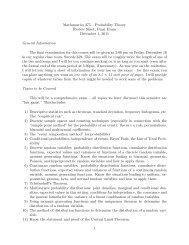Research Statement - Mathematics and Computer Science
Research Statement - Mathematics and Computer Science
Research Statement - Mathematics and Computer Science
Create successful ePaper yourself
Turn your PDF publications into a flip-book with our unique Google optimized e-Paper software.
Sarah Wright - <strong>Research</strong> <strong>Statement</strong> 2<br />
In Figure 1(b), we can see that there is a path from vm to vn if m > n <strong>and</strong> a path from v1 to any<br />
other vertex. These two observations together give a path from any vertex to any other vertex, so<br />
the graph is cofinal.<br />
v1<br />
v2<br />
(a) Cycle Without Entry<br />
(b) A cofinal graph<br />
(c) The Graph En<br />
Figure 1: Three Examples of Directed Graphs<br />
The existence of entries for each cycle <strong>and</strong> the cofinality of the graph relate to the structure of the<br />
C ∗ -algebra by the following theorem of Kumjian, Pask, Raeburn, <strong>and</strong> Renault. The requirement<br />
of a graph to be row-finite (each vertex receives only finitely many edges) was later dealt with by<br />
Drinen <strong>and</strong> Tomforde yielding a similar theorem in [4].<br />
Theorem. [15, Theorem 4.14] Suppose E is a row-finite graph in which every cycle has an entry.<br />
Then C ∗ (E) is simple if <strong>and</strong> only if E is cofinal.<br />
In particular, this theorem tells us the C ∗ -algebra associated to the graph En, Figure 1(c), which is<br />
the Cuntz algebra On, is simple when n ≥ 2. As the Cuntz Algebra is well-studied, its simplicity is<br />
not new upon the proof of this theorem, but the ease with which the theorem is applied demonstrates<br />
its importance <strong>and</strong> beauty. There are further theorems in the field that give a description of the<br />
ideal structure of a graph-algebra, see [2, 8]. Similar to the theorem above, the results give a way<br />
to nearly “read-off” the ideal structure of the algebra from properties of the graph.<br />
The study of graph algebras had been particularly fruitful in its provision of a rich class of easily<br />
accessible examples of C ∗ -algebras with various properties. To this end, the idea of a graph has been<br />
generalized in many ways to provide even more examples. The long list of generalizations includes<br />
the labeled graphs of Bates <strong>and</strong> Pask where edges of the graph are labelled from an alphabet set, the<br />
k-graphs of Kumjian <strong>and</strong> Pask, where rather than paths of length ℓ ∈ N we work with k-dimensional<br />
paths of shape n ∈ N k , <strong>and</strong> the topological graphs of Katsura, where instead of discrete sets of<br />
vertices <strong>and</strong> edges we give these spaces interesting topologies. For definitions of these structures see<br />
[1], [12], <strong>and</strong> [11] respectively. Most recently the work of Yeend provides a generalization of both<br />
higher-rank graphs <strong>and</strong> topological graphs, with the unifying theory of topological k-graphs [21].<br />
2 Aperiodicity Conditions <strong>and</strong> Related Results<br />
The importance of cycles having or not having entries is the idea of being able to “back out of a<br />
cycle” <strong>and</strong> build an aperiodic infinite path. (The convention to construct paths backward comes<br />
from the methods used to construct the associated C ∗ -algebra.) The relationship between the<br />
periodic paths (or lack there of) in the graph <strong>and</strong> the simplicity of the associated C ∗ -algebra is<br />
an important result for all types of graphs. The C ∗ -algebras of directed graphs, k-graphs, <strong>and</strong><br />
topological k-graphs were all originally constructed using groupoid methods (a well-studied method<br />
of constructing a C ∗ -algebra that generalizes the algebra generated by a group). More elementary<br />
methods for construction have been established since these initial works. As the infinite paths of<br />
the graph play such a central role in the groupoid construction of the C ∗ -algebra, in the case of<br />
higher-rank graphs, the original aperiodicity condition, called Condition (A), was stated in terms<br />
v3<br />
v4<br />
v5<br />
v6<br />
en<br />
.<br />
e3<br />
e2<br />
e1<br />
v


